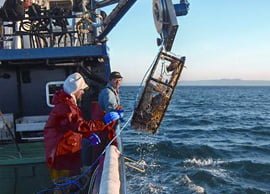Dungeness Crab
Importance of Dungeness Crab to Oregon
Dungeness crab is an important part of the Northwest’s seafood heritage, and has been commercially harvested since the 1800’s. Dungeness crab are salt water, ocean creatures. Their range extends from central California to the Gulf of Alaska. The Dungeness crab fishery is Oregon’s most valuable ‘single species’ fishery. In 2013, Oregon harvested, or landed, 26.1 million pounds of Dungeness crab. Oregon named Dungeness crab the state crustacean in 2009.
Life Cycle of a Dungeness Crab
Hatching
Crab hatch as tiny larvae that live among other tiny animals in the sea. They swim near the surface and feed on even smaller organisms.
Zoea Larva
The first stage after hatching is called zoea larva. The larva has a long spine behind its head to help prevent predators from eating it.
Megalops Larva
The second stage is called a megalops larva. This stage looks more like a crab, but the abdomen is large and stretched out, not folded beneath the rest of the body. Crab stays in the larval stage for up to 12 months where they are free-floating and vulnerable to the ocean and predators.
Juvenile to Adult
By the time the crabs are the size of a dime, they settle on the bottom of the ocean floor. During their first two years, crabs shed their shells many times. Each time they shed their shells they get bigger. They are mature adults after 2 years.
Growing New Legs and Molting
A crab can grow new legs to replace the ones it loses. Limbs may be bitten off in a fight with a rival crab, or while a crab is trying to escape from a predator. Some crab may shed a limb if it is being grasped. When a limb is lost or shed, a new one starts to grow as a tiny bud almost immediately. As it re-grows it triggers molting. After two molts, the new limb will be as large as the original.
Just as we outgrow our clothes, crab outgrow their shells. Crab have a hard outer shell that does not grow as the rest of its body does. As the crab grows larger, they must shed their shells, in a process called molting.
Right before molting, a crab takes nutrients from its old shell and then separates from it by absorbing seawater, swelling up like a balloon, and causing the shell to come apart. Next, the skin grows a soft, paper-like shell beneath the old one. This process can take several weeks.
When a crab molts it removes all its legs, eye stalks, antennae, all its mouthparts, and its gills. It leaves behind the old shell, the esophagus, its entire stomach lining, and even the last half inch of its intestine. Often a large group of crabs will molt at the same time, and their old shells wash up on the beach.
Molting is a very dangerous time for crabs because they are soft and defenseless for days afterward. The crab cannot walk because its legs will not support its weight, and it cannot eat.
If you find something on the beach that looks like a dead crab, pick it up, open the lid, and look closely inside. If nobody is home, it is a cast-off exoskeleton!
Dungeness Crab in Motion
Crab walk sideways, not forward and backward. The reason for this is the long walking legs are so close together on each side of a crab’s short body that if it were to move forward or backward, the legs would trip over each other.
What Do Dungeness Crab Eat?
Most crab will eat almost anything, plant or animal, dead or alive. Animals that have such a wide range of food items in their diet are called omnivores.
Dungeness Crab Reproduction
Dungeness crabs can only successfully mate when the female is newly molted.
In the early spring, adult male crab look for female crab likely to molt soon. When a female crab is ready to mate, she sends signals the male crab recognize. Female crabs produce special chemicals that males pick up and follow. When they meet, a male and female may touch each other with their antennae to let each other know they are not going to attack.
The male may carry the female for a few days before mating with her. Crabs will stay in this “pre-mating embrace” until females molt, this can go on as long as two weeks. They mate just after the female has molted. The male continues to carry her around to protect her until her new shell has hardened.
After the female has mated, eggs develop inside her body until they are ready to be laid in one large egg mass. She holds this mass of eggs under her body. The eggs are kept in place by her flap-like abdomen and clasped by the tiny limbs until they are ready to hatch.

The female holds her eggs in a special flap on her abdomen until they
are ready to hatch
Dungeness Crab Harvest
Crab Season
Oregon’s commercial crabbing season generally begins December 1 and continues through August 14. The peak harvest occurs during the first eight weeks of the season, with up to 75% of the crab harvested during that time.
Commercial Harvesting
Dungeness crab has been commercially harvested along the Pacific coast for over 150 years. The typical landing, or harvest, in Oregon is about 10.3 million pounds.

Commercial Crabbing
Commercial crabbers catch Dungeness crab in circular steal traps commonly called pots. A full crab pot can weigh 60-125 pounds. The pots are baited with squid or razor-clams. They are allowed to soak or float in the open ocean for one to four days.
Crabbing is an extremely dangerous job. Crabbers go out in boats and drop pots at depths 30 to 600 feet deep. The average boat fishes 300-500 pots at once. Crabbers work in round-the-clock shifts. The vessels used to harvest crabs range from small wooden trollers with two-men crews to large steel combination vessels with four-men crews.
Most of Oregon’s coastal seafood processors purchase and process Oregon-grown Dungeness crab during the season.
Recreational Crabbing
Recreational crabbing is open year-round; however, fall is typically the best time to crab. Beginning in September, crab will tend to be more filled out, meaning there is a higher percentage of quality meat. Crabbing in the ocean is closed for Dungeness crab from October 16 to November 30.
Measuring Crab
Dungeness crab live about eight to ten years and grow to nine-plus inches. Mature males that are 6 ¼ inches across the back of the shell or more are legal to harvest. For recreational harvesting it is legal at 5 ¾ inches across the back, but not including the spines. Undersized male crabs must be returned to the ocean to insure healthy breed stock. It is illegal to harvest female crabs.
Crab Byproducts
Crabmeat is a popular northwest favorite and can be eaten fresh, frozen, canned, smoked, or dried. A variety of by-products are also made from Dungeness crab, including fertilizers for home gardens and farm, cat food, mink food, aquaculture fish food, nutritional supplements and flavor ingredients.
Vocabulary Terms
Carapace
name of the crab’s shell
Chelipeds
the two front legs on a crab that have claws
Chemorecptors
antennae on crabs that are used for taste and smell
Crustaceans
an animal that has an exoskeleton or shell that protects the body
Decapod
a ten-footed animal
Exuvia
cast off crab shells as a result from molting
Filled out
when crabs have the highest percentage of quality meat
Landed
the average annual harvested amount
Megalops larva
the second stage in the crab’s life cycle
Omnivores
animals that eat both plants and other animals
Pots
circular steal trap that is used to catch crabs
Slack tides
time of peak high or low tide
Zoea larva
the first stage in a crab’s life cycle after hatching
